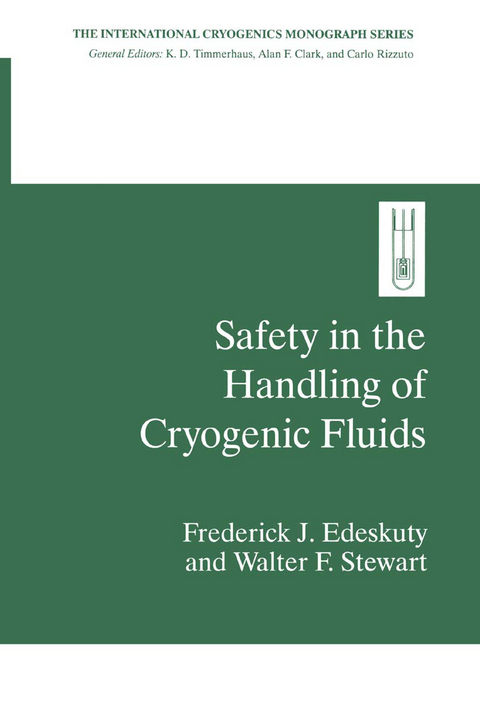
Safety in the Handling of Cryogenic Fluids
Seiten
2013
|
Softcover reprint of the original 1st ed. 1996
Springer-Verlag New York Inc.
978-1-4899-0309-9 (ISBN)
Springer-Verlag New York Inc.
978-1-4899-0309-9 (ISBN)
However, when cryogenic temperatures are involved, safety is especially important. Cryogenic liquids, such as oxygen, nitrogen, hydrogen, and helium, have become commonly used in a number of different applications and are easily available in any part of the United States and, indeed, almost anywhere in the world.
The importance of safety in any scientific endeavor is never in question. However, when cryogenic temperatures are involved, safety is especially important. In addition to observing the normal precautions, one must also take into account the variations of physical properties that occur at low temperatures. At these tempera tures, some properties not only exhibit large differences from their normal values but also can vary widely over a small temperature range. Before any cryogenic project is started, a thorough knowledge of the possible hazards is necessary. Only in this way can the safest operation be attained. Over the hundred-year history of cryogenic research, this has been shown to be the case. Keeping this requirement in mind is an essential ingredient in the quest for accident-free work. The past four or five decades have seen a great expansion of cryogenic technology. Cryogenic liquids, such as oxygen, nitrogen, hydrogen, and helium, have become commonly used in a number of different applications and are easily available in any part of the United States and, indeed, almost anywhere in the world. Not only are these liquids available, they have become less expensive and also available in ever larger quantities. As quantities increase, so also do the conse quences of mishaps. The future seems to hold promise of ever larger and more widespread use of the common cryogens. Thus, the importance of safety also increases as time progresses.
The importance of safety in any scientific endeavor is never in question. However, when cryogenic temperatures are involved, safety is especially important. In addition to observing the normal precautions, one must also take into account the variations of physical properties that occur at low temperatures. At these tempera tures, some properties not only exhibit large differences from their normal values but also can vary widely over a small temperature range. Before any cryogenic project is started, a thorough knowledge of the possible hazards is necessary. Only in this way can the safest operation be attained. Over the hundred-year history of cryogenic research, this has been shown to be the case. Keeping this requirement in mind is an essential ingredient in the quest for accident-free work. The past four or five decades have seen a great expansion of cryogenic technology. Cryogenic liquids, such as oxygen, nitrogen, hydrogen, and helium, have become commonly used in a number of different applications and are easily available in any part of the United States and, indeed, almost anywhere in the world. Not only are these liquids available, they have become less expensive and also available in ever larger quantities. As quantities increase, so also do the conse quences of mishaps. The future seems to hold promise of ever larger and more widespread use of the common cryogens. Thus, the importance of safety also increases as time progresses.
1 Introduction.- 2 Physiological Hazards.- 3 Embrittlement of Materials.- 4 Stresses Caused by Thermal Contraction.- 5 Buildup of Pressure in Closed Systems.- 6 Condensation.- 7 Combustion Hazards.- 8 Combustion Properties.- 9 Oxygen Hazards.- 10 Slush Hydrogen.- 11 Guidelines, Standards, and Regulations.- 12 Safety Problems Needing Further Investigation.- 13 Accidents: Prevention and Examples.- Appendix A Some Pertinent Details of the Code of Federal Regulations.- Appendix B List of Symbols.- Appendix C List of Acronyms.
| Reihe/Serie | International Cryogenics Monograph Series |
|---|---|
| Zusatzinfo | XVII, 234 p. |
| Verlagsort | New York |
| Sprache | englisch |
| Maße | 152 x 229 mm |
| Themenwelt | Naturwissenschaften ► Chemie ► Technische Chemie |
| Naturwissenschaften ► Physik / Astronomie ► Festkörperphysik | |
| Naturwissenschaften ► Physik / Astronomie ► Thermodynamik | |
| Technik | |
| ISBN-10 | 1-4899-0309-7 / 1489903097 |
| ISBN-13 | 978-1-4899-0309-9 / 9781489903099 |
| Zustand | Neuware |
| Haben Sie eine Frage zum Produkt? |
Mehr entdecken
aus dem Bereich
aus dem Bereich
Grundlagen, technische Anwendungen, Rohstoffe, Analytik und …
Buch | Softcover (2023)
Springer Vieweg (Verlag)
39,99 €
erneuerbare Energien und Speichertechnologien für die Energiewende
Buch | Softcover (2023)
De Gruyter Oldenbourg (Verlag)
69,95 €
Daten, Formeln, Normen, vergleichende Betrachtungen
Buch | Softcover (2024)
Europa-Lehrmittel (Verlag)
38,90 €


